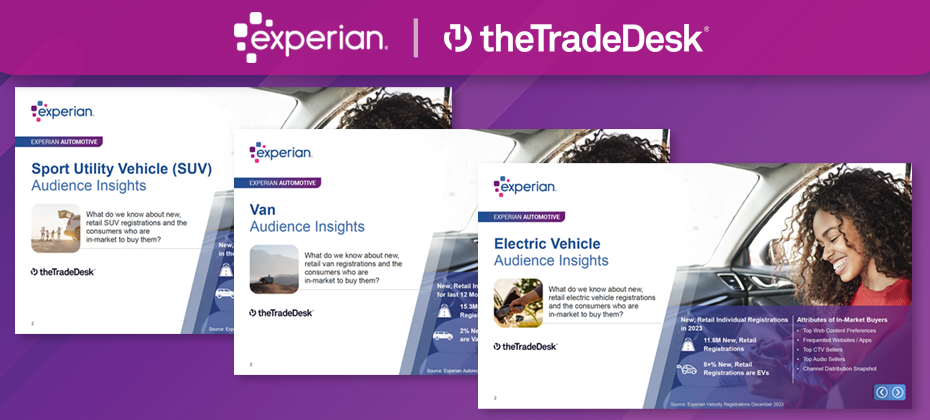Automotive Marketing

For car dealers, the holy grail isn't a flashy sports car or a top-selling SUV. It's a simple whisper: "I'm thinking about getting a new car." Imagine if you could hear that murmur from every potential customer walking through your doors, online, or even driving down the street. That's the power of knowing who's in the market for a new car, and it's a game-changer for dealerships. Go beyond the cookie and website tracking and leverage the power of psychographic data and predictive analytics to know who is coming into the market in the next 30, 60, 90 days with the Experian Marketing Engine’s Affinity AutoAudiences. Boost Efficiency and ROI: Targeted Sales: No more shotgun blasts of marketing campaigns! Precisely target consumers considering a new car with personalized offers and incentives. Imagine tailoring financing proposals based on their budget and desired features, not guesswork. Inventory Optimization: Say goodbye to dusty lots filled with unsold models. Knowing market trends and individual preferences allows you to stock in-demand vehicles, maximizing sales and minimizing depreciation costs. Streamlined Sales Process: When a customer walks in already open to buying, the entire process becomes smoother. Focus on addressing their specific needs and preferences, leading to quicker deals and happier customers. Build Stronger Customer Relationships: Proactive Engagement: Instead of waiting for leads, reach out at the perfect moment. A friendly call or email during their research phase demonstrates attentiveness and builds trust, setting you apart from the competition. Personalized Recommendations: Forget one-size-fits-all pitches. Recommend models based on their lifestyle, budget, and driving habits. This shows genuine interest and builds rapport, increasing the likelihood of conversion. Enhanced Customer Experience: Cater to their specific needs before they even step onto the lot. Offer virtual test drives, online financing options, and even home delivery – all tailored to their preferences. This level of personalized service fosters loyalty and repeat business. Leverage the Power of Data: Knowing when a consumer is in the market for a new car isn't just about a head start, it's about building trust, offering convenience, and tailoring the entire experience to their needs. In a competitive market, this inside knowledge is the key to unlocking increased sales, stronger customer relationships, and ultimately, a thriving dealership. So, what are you waiting for? Start listening and turn those whispers into deals! Or

Experian's Automotive Consumer Trends Quarterly Report goes beyond understanding general car-buying trends. Each quarter, we delve deeper into a specific vehicle segment, analyzing the demographics (who's buying) and psychographics (why they're buying) of those consumers. New eBrochures help turn insights into action Although valuable, what can you do with this information? That's where The Trade Desk comes in. They leverage the insights from our report to create a comprehensive omnichannel strategy for reaching in-market car buyers. This strategy goes beyond demographics, revealing: Top web content preferences: Where are these consumers spending their online time? Frequented websites and apps: What digital platforms are most relevant to them? Top CTV and audio examples: Which streaming services and audio channels should be targeted? A Consolidated Snapshot The Trade Desk provides a clear picture of channel distribution, ensuring your advertising reaches the right audience across the most effective platforms. This combined approach empowers you to target car shoppers with laser precision, maximizing your advertising impact. Experian Automotive and The Trade Desk are committed to developing solutions that balance advertiser needs with consumer privacy. The Trade Desk’s clients can access Experian’s over 2,400 syndicated audiences across eight verticals, including over 750 automotive audiences by make, model, fuel type, price, vehicle age, and more. Accessing the insights: To view the latest Experian Automotive Consumer Trends Quarterly Report, visit us at: www.experian.com/automotive/auto-consumer-trends-form. You can review Experian and The Trade Desk’s collaborative eBrochures for the following vehicle segments:

The deprecation of third-party cookies is one of the biggest changes to the automotive digital marketing landscape in recent years. Third-party cookies have long been used to track users across the web, which allows advertisers to target them with relevant ads. However, privacy concerns have led to the deprecation of third-party cookies in major browsers, such as Google Chrome and Safari. This change will have a significant impact on automotive marketers, as it will make it more difficult to track users and target them with ads. However, there are several things that auto marketers can do to prepare for the cookieless future. Here are some marketing tips when the cookie deprecates: Focus on first-party data. First-party data is data that you collect directly from your customers, such as email addresses, contact information, and purchase history. This data is more valuable than third-party data, as it is more accurate and reliable. You can use first-party data to create targeted ad campaigns and personalize your marketing messages. Work with a third-party aggregator. Automotive marketers can tackle a cookie-less world by using other sources of consumer data insights. For instance, a third-party data aggregator, like Experian, has access to numerous sources, platforms, and websites. Beyond that, we have access to a vast range of specific consumer data insights, including vehicle ownership, registrations, vehicle history data, and lending data. We take all that information and help marketers segment audiences and predict what consumers will do next. Leverage Universal Identifiers. Universal Identifiers provide a shared identity to identity across the supply chain without syncing cookies. First-party data (such as CRM data) and offline data can be used to create Universal Identifiers. Use contextual targeting and audience modeling. Contextual targeting involves targeting ads based on the content that a user is viewing. Contextual targeting is a privacy-friendly way to target ads and it can be effective in reaching relevant audiences. Utilize Identity Graphs. An identity graph combines Personally Identifiable Information (PII) with non-PIIs like first-party cookies and publisher IDS. Identity graphs will allow cross-channel and cross-platform tracking and targeting. Experian’s Graph precisely connects digital identifiers such as MAIDS, IPs, cookies, universal IDs, and hashed emails to households providing marketers with a consolidated view of consumers’ digital IDs. The deprecation of third-party cookies will be a challenge for auto marketers, but it's also an opportunity to rethink marketing strategies and focus on building stronger relationships with customers. Here are some additional cookieless marketing tips: Start preparing now. Don't wait until the last minute to start preparing for the cookieless future. Start collecting first-party data from your customers now. Be transparent with your customers. Let your customers know what data you are collecting and how you are using it. Make sure that you have their consent to collect and use their data. Be creative with your marketing campaigns. There are several ways to reach your target audience without relying on cookies. Be creative with your marketing campaigns and experiment with different strategies. Sample audience segments include: Consumers in market Loan status In positive equity Driving a specific year/make/model 1000+ lifestyle events such as new baby, marriage, new home Geography, demographics, psychographics To take it to the next level, we can use predictive analytics to go beyond what cookie data could provide by predicting who is ready to purchase a vehicle. For example, an auto marketer may have used cookie data to find buyers who had shown interest in a hybrid sedan, but that’s where it ended. When combining audience segmentation with a predictive model, marketers can target and identify consumers in-market and most likely ready to purchase a specific model. In this way, the data-driven insights from a third-party data provider specializing in automotive insights can replace the cookie-driven approach and take it a significant step beyond. The cookieless future is coming, but marketers who are prepared will be able to succeed. By focusing on first-party data, contextual targeting, and partnerships, auto marketers can reach their target audiences and achieve marketing goals.

A funnel describes marketing and sales opportunities because it is the widest at the top and narrowest at the bottom. This is an accurate representation because only a fraction of consumers who enter a sales funnel will become buyers. At the top of the funnel, you find consumers exploring and learning about purchase options. These consumers respond to awareness-based marketing regarding vehicle features or comparisons. They are not typically focused on pricing but rather just learning about options. In the middle of the funnel is where you find customers getting closer to a vehicle purchase. They are evaluating their options, including new versus used, and exploring specific units on consumer sites. These consumers have moved beyond general market awareness and vehicle feature interest and into evaluating what vehicle features meet their needs and what price range and financing options may best suit their budget. During this time, marketing and sales contacts with specific incentives or vehicles of interest-based marketing are effective. Nearing the lower funnel As you near the lower funnel, you will find consumers who are initiating the process with the intent to purchase. These consumers are visiting consumer shopping sites for used vehicle research as well as dealer websites. Used vehicle consumers are visiting Vehicle Detail Pages (VDPs) and viewing vehicle history reports. These lower funnel consumers are exploring trade-in values and trying to put together their vehicle sale and purchase plan. There are many ways lower funnel opportunities interact with the automotive ecosystem. With improvements in digital retailing even when just one small part of the sales process is initiated prior to the consumer visiting the brick-and-mortar store, dealers have an opportunity to capture these lower-funnel consumers. Some effective examples include quick “sell your trade” links or prequalification links on web pages that allow consumers to obtain trade values/trade offers and, in some cases, to get full prequalification for loans. Often these digital retailing features are able to track and communicate to dealers about these lower funnel and fully engaged consumers. Take advantage of lower funnel leads with digital retailing tools As online digital retailing steps become more commonplace, dealers will find themselves leveraging these leads for sales. Utilizing effective, consumer-friendly, and secure functions that allow consumers to access or work through the components of a sale will maximize engagement. Keeping consumers tied to your website during the process can keep them working with your dealership processes. To learn how Experian Automotive can help you gain lower funnel opportunities, contact Mike Costanzo.

Dealers are always looking for reasons to connect with consumers. From back-to-school or graduation specials to holiday offers, dealers leverage seasonal and routine aspects of daily life to connect with consumers. Tax season offers a unique annual opportunity to position your vehicles and dealership for purchase by a consumer expecting a tax refund. In many cases, even consumers not receiving a hefty tax refund will be receptive to the tax time message. With the right strategy, message, and audience, you can market to consumers who are a few thousand dollars richer! Consider a tax refund match program Even if you are not in a position to offer consumers extraordinary sales offers, you may be able to create some special dealership-level seasonal offers that take your tax refund message to the next level. For example, offering a Tax Refund match program that offers consumers a discount off a vehicle matching the tax refund applied as a down payment would surely make your dealership stand out! Target consumers with service incentives What about consumers who did not expect refunds or have already spent them? Perhaps offering service incentives such as offering free tax filing software with the purchase of a prepaid service plan would be appealing. Or simply incentivize consumers to receive a discount coupon book during tax season to lighten the burden tax season brings.Tax season often sets the stage for the spring and summer vehicle sales season. Setting the stage by offering service incentives and tax refund matching programs creates rapport with your consumers that you can build upon. Start developing more effective marketing strategies The Experian Marketing Engine (EME) gives dealers and agencies the ability to build effective marketing plans by providing comprehensive market analysis along with powerful audience list creation. Tax time is just one of many messages dealers can deploy utilizing EME's solutions. At Experian Automotive, we leverage our world-class data set to give our dealer and agency clients unparalleled information to market effectively. If you find this topic interesting, you should read one of our others blogs, How to Effectively Use Audiences for Traditional and Online Marketing.

In the last decade, electric vehicle registrations have increased by 3,600%, and the demand for alternative fuel vehicles continues to soar. Manufacturers are rapidly expanding alternative fuel operations to keep up with the demand from consumers that has expanded across all generations. Target in-market EV consumers Today’s automotive marketers understand that finding targeted consumer audiences is critical to a successful marketing strategy. With more electric vehicle model options available and improved infrastructure driving popularity, we’re seeing automotive marketers wanting to target in-market EV consumers as well as current alternative fuel vehicle owners. Applying data-driven insights to find targeted consumer audiences is critical to today’s marketing strategies. For example, as of Q2 2022, 23.5% of plug-in hybrid owners that returned to market, migrated to an electric vehicle As a marketer, would it be helpful to select In-Market Likely Segment Switchers as your target audience for your marketing campaign? Or Hybrid owners as a whole? Experian Automotive has a variety of alternative fuel owner audiences and in-market consumer audiences to help marketers target the right consumer with the right message on the right channel. The Experian Marketing Engine Syndicated Auto Audience portfolio includes 70+ audiences focused on likely buyers and owners of Electric Vehicle (EV) and Plug-In Hybrid (PHEV) vehicles. Of Experian’s 750+ syndicated auto audiences, we offer a subset of over 25 audiences focused on individual EV/PHEV vehicle models. How to find EV audiences on your preferred platform Experian electric vehicle audiences are available in the Auto Audience area of your preferred platform. Simply navigate to Experian Automotive’s Audiences to find Electric Vehicle related audiences, as well as all of Experian’s Auto Audiences. To learn more about Auto Audiences for Electric Vehicles, contact our Subject Matter Expert, Gary Meteer.

Strategic automotive marketing and measurement are getting more complicated with the increase in consumer channels and devices. This makes it harder for marketers to obtain a complete measurement picture. Measurement terminology is also evolving. Here's a look at some of today’s key definitions to familiarize you with the nuances and challenges it may already bring to your analytics. What is the open web? The open web is the web as a whole or the public side of the web with all the millions of sites that do not require a subscription or fee to use them. For example, in our industry, this would be an auto manufacturer’s website, a dealership’s website, or an online consumer shopping portal where you list your vehicles for sale – all of these are on the open web. These sites use open-source standards to deliver content to consumers without a separate app or company acting as gatekeepers. However, tracking approaches on the open web will shift as cookies will eventually disappear. What is a walled garden? A walled garden is a closed platform or ecosystem (e.g., Amazon, Apple, Facebook) wherein the platform provider controls the content, applications, and/or media and restricts access as it sees fit. The publisher offers consumer privacy and rich first-party data to advertisers, but the measurement is limited to activity within the ‘walls’ of the garden. From an advertising perspective, buyers can only access these platforms through their own buying tools; they do not give access to any independent platforms. The publisher (the Walled Garden) handles all the buying, serving, tracking, and reporting within their ecosystem. So, let’s say you are an automotive consumer checking out vehicles. If you’re reading your Facebook feed on your phone and you see an advertisement for a vehicle or a dealership, that OEM or dealership is advertising in a walled garden – in this case, the walled garden is Facebook. The challenge to an advertiser is that they can only measure activity that occurred within that ecosystem using the walled garden’s platform and measurement tools. What is a hedged garden? The “hedged garden” is a new industry concept. A hedged garden is when a network of publishers work together to activate first-party data sets in a privacy-compliant way across many partners at scale. These publishers run their businesses with large amounts of first-party consumer data. They often do not own or operate complete buying stacks. For example, companies like Target and Walmart let advertisers employ their data on shoppers for ad targeting, but brands can use their own buying tools. Other examples of a hedged garden might include Connected TV platforms such as Vizio’s or Samsung’s in-house ad businesses. If you’re sitting on your couch watching your Vizio-connected TV and you see an advertisement for a dealership or a manufacturer, they are advertised within that hedged garden. As an advertiser, the advantage is that you can use their buying tool when targeting shoppers for your advertising. How to fill in the gaps the walled garden may leave open The walled garden can challenge marketers who desire cross-channel activation and measurement. If you're a marketer working within a walled garden, we can work with the data you have to give you a complete picture of your audience’s digital journey. Our experience and vast databases, including vehicle, credit, and customer insights, allow us to continue building strong partnerships within the fast-growing (Hedged Garden) ecosystem. We can help. Our Subject Matter Expert, Laurel Malhotra will be happy to answer any questions you may have. Contact her today.

In honor of all the marketers who frantically created and activated audiences for Cyber Five sales (Thanksgiving Day through Cyber Monday), this blog announcing a resource for automotive marketers on how to best activate their automotive audiences is timely! I realize the following spending stats are totals for consumer spending, not just automotive consumer spending, but these dollar amounts put advertising and media spending into perspective. Adobe Analytics reported that consumers spent $35.4 billion online over the Cyber Five period this year, breaking a record. Many marketing campaigns ran on various channels to reach that many consumers. Strategic campaign development is key to effective activation Marketers know all the hard work that goes on behind the scenes before media is activated. As automotive marketers, let’s recap what typically happens before activation even begins. It is common to begin by linking fragmented consumer data across channels, platforms, and devices into unified customer profiles for more effective cross-channel targeting. Using identity solutions helps marketers target the right consumers on the right channels. After unifying customer profiles, marketers often look at auto-specific market, vehicle, and consumer data insights to help gain a deeper understanding of market competition and opportunities, vehicle interest, and critical consumer information (demographics, psychographics, etc.) Next, many marketers leverage automotive, lifestyle, and predictive data to target specific consumer segments across all channels for true omnichannel marketing. Once this is complete, marketers can choose their audience, depending on what their goals are and which channels they are focusing on. Once all this pre-work is finished (and I over-simplified all the hard work behind these steps), marketers need to Activate their campaigns by selecting the best channels. Leverage various media partners and platforms At Experian Automotive, we believe marketers can improve their ability to reach their intended audience participants and measure their overall campaign results if they are strategic during Activation. Leveraging various media partners and platforms allow marketers to activate audiences more effectively and execute more strategic, measurable, multi-channel marketing campaigns. The key is to find a vast network of media destinations and onboarding capabilities that empowers you to activate audiences and connect with a single audience across channels delivering personalized, addressable experiences. To help auto marketers understand all the areas of Activation, we’ve written a resource, How to Activate Your Audience on the Most Strategic Channels, that you can download now. We’ve also written these other resources to help automotive marketers use data insights to develop more strategic, measurable marketing campaigns. They are all complimentary so feel free to download them too! Identity Solutions: Helping Marketers Deliver Personalized Communication for Life Audiences: Automotive Audience Choices are Key to Ever-Changing Strategies Customer Insights: Understand Your Customer Before Choosing Your Audience Measurement: Measuring Marketing Performance is Critical to Long-Term Succes

When your marketing strategies don’t go as planned, don’t you wish you could have taken a “mulligan?” In today’s marketing world, it’s normal and critical to measure marketing effectiveness.

Did you know that GenX had the most Hybrid owners migrate to Electric Vehicles in 2021? And believe it or not, the next group behind GenXers were Boomers! That’s right, not millennials or GenZ…Boomers! We have many more details to share on the Electric Vehicle segment and the consumers in that segment who buy them in our newly released Experian Automotive Consumer Trend Report: Q2 2022. Every quarter, Experian’s Automotive Consumer Trends Report provides insights into specific vehicle segments and the associated consumers within that segment. This quarter focuses on the Electric Vehicle (EV) market. The report answers these questions: How many EVs are on the road? Where are they located? How have recent EV registrations shifted the geographic distribution? Which manufacturers are selling those vehicles? Who is taking market share from whom? Who are the consumers who registered those vehicles? What are the demographic and psychographic insights for those consumers? There are two ways to receive the report information: Watch the on-demand presentation of the report while our analyst provides critical insight & analysis OR Download a PDF version of the report At Experian Automotive, we understand that marketers need to deeply understand consumers to develop targeted, effective marketing strategies. Whether you are an OEM marketer, an agency, or an auto dealer, our presentation will transform complex market data into actionable insights that you can begin using immediately.

To help your marketing dollars go further in 2022, developing multichannel strategies that more efficiently incorporate both traditional and online consumer audiences is key to more effective campaigns. Doing this well requires marketers to understand your consumers and how they best respond to marketing, including what channel (direct mail, email, OTT banner ads) or what message (vehicle reliability, value for dollar, celebrity endorsement) works best. Working with the right partner for audience insights enables you to segment audiences and filter for automotive criteria that drive more targeted, segmented marketing. What are traditional audiences? In most cases, traditional (sometimes referred to as offline) audiences include consumers reached through radio, standard TV, billboards, text, direct mail, or phone calls. To fulfill any traditional audience strategy, a dealer or agency requires consumer Personally Identifiable Information (PII) such as name, email address, mailing address, or phone number. Traditional marketing has also been called direct marketing when the marketing is sent specifically to a home address, email address, or phone number. For instance, when utilizing direct mail, automotive marketers require the most up-to-date consumer information to ensure they reach the correct mailbox. To reduce cost and personalize the marketing experience, the best marketers utilize audience sources based on strong data sets unique to the automotive world. For example, targeting consumers driving a particular vehicle or nearing the end of their lease is more effective than just sending a generic message to an entire geographic area. Even with the explosive growth of digital marketing, direct marketing remains relevant. Consumers still respond and use offers sent to their mailboxes, and personalized mailers still result in vehicle sales or service appointments. While there is a higher cost per thousand than digital marketing, direct marketing still earns an essential place in the automotive retail media mix. What are online audiences? Online audiences are typically consumers reached through 0ver-The-Top (OTT) advertising, banner ads, or addressable TV. When using these marketing channels, PII is not needed. Online marketing can encompass many different methods to reach customers, including social media, email, websites, blogs, and search engine traffic. Nearly every business will benefit from online marketing because it's a great way to reach people where they already are—online. Online marketing has grown in a digital world where so many people rely on their cell phones to organize their day, conduct research, and communicate with the world. According to Tech At Last, “most households now have between 5 and 10 screens. Those numbers include tablets, PCs, notebooks, smartphones, and televisions. These devices include any screen that enables users to watch or read content.1 Audience modeling can help simplify the chaos of digital channel segmentation Utilizing digital channels allows marketers to reach consumers where they increasingly spend their time. Whether it is their Inbox, streaming service, social media, or other digital platforms, knowing consumer preferences makes the marketing experience more meaningful. In other words, capitalizing on audience modeling to determine the best channel and how the consumer engages with the channel can make all the difference. For example, to showcase your new Hybrid, you may not want your video advertising shown on a YouTube channel about construction! The same commercial would resonate far better on a channel with DIY or gardening shows. To best capitalize on addressable TV, 0ver-The-Top advertising, or banner ads, marketers should work with an audience provider who can identify targeted segments based on psychographic, demographic, and geographic data allowing for more effective marketing. Look for a provider like Experian Automotive that can deliver a robust database, extensive consumer insights, and deeply established partnerships for audience activation (social media or TV), allowing your marketing dollars to work harder with extended reach. Whether you are looking to reach consumers online or traditionally, reaching the right consumers with the right message on the right channel is always the goal. To achieve this, working with a third party for audiences built on clean data is necessary. If you can segment the audiences or filter for automotive criteria, your marketing dollars and messaging will go farther! 1TechAtLast (2014) The Average Number of Screens in a Home Has Increased

I love the random “National” holidays that are popping up. Did you know we recently celebrated National Chocolate Chip Cookie Day? It’s no 4th of July or Labor Day, but I love cookies, so I’m gonna roll with it. Today, we will chat about Identity Resolution in relation to strategic marketing. So, believe it or not, I’m going to tie in Identity Resolution to chocolate chip cookies! (By the way, if you haven’t read my last two blogs, this is a trend! Check it out:) Use Data Insights for an Eagle’s Eye Approach to Marketing (National American Eagle Day) Building the Perfect Audience is Like Building the Perfect Burger (National Hamburger Month) What is identity resolution? Identifying who you want to target as part of a strategic marketing campaign is critical as a marketer in the auto industry. Experian defines this process as identity resolution or “the ability to stitch together and unify the names, addresses, emails, device IDs, cookies (not the yummy kind), and other identifiers associated with customers.” Today’s marketers risk working with outdated, fragmented, or incomplete data without proper identity resolution, which correlates to inefficient campaign targeting and wasted marketing dollars. So, let’s use baking a chocolate cookie as an example. For the perfect cookie, you need flour, white sugar, brown sugar, salt, baking soda, butter, vanilla, eggs, and chocolate chips. There are a lot of ingredients, and you need all of them to make a complete cookie. When it comes to targeting consumers, let’s say you only have fragmented pieces of customer information for a woman who bought a car from you (partial ingredients). You have her name, the address where she lived when she purchased the car, and what looks like a work email address (that has bounced). So, it’s like having the flour, eggs, and sugar for your cookie! But you need the rest of the ingredients for the recipe, and you need to confirm whether any key ingredients have expired or “gone bad.” Or you may have customers you know through analytics who have visited a dealer or OEM website, but you can’t track them down further. You have an electronic footprint but no other identifying data. So, you have the critical ingredient like flour, but it’s not necessarily super helpful unless you have other pieces to complete the recipe. Find the missing ingredients with identity resolution solutions Marketers need to utilize solutions like data hygiene, database management, additional data append, digital identity resolution (to link anonymous online IDs to data assets), and identity graphs to help create a complete view of their customers and prospects. In other words, some solutions can help bring all the ingredients together to make a “whole” cookie or a “whole” customer. You’re ready—add the chocolate chips and bake! I realize that identity resolution can be complicated, so we’ve written a resource with examples/scenarios and the corresponding solutions that can help resolve typical challenges. Download a complimentary copy of Identity Resolution: Helping marketers deliver personalized communication for life. At Experian Automotive, we are experienced in unifying fragmented data points across offline and online touchpoints to create a complete view of your best auto customers and prospects. Feel free to reach out to discuss our solutions or to share your favorite chocolate chip cookie recipe.

Last month my blog discussed how Building the Perfect Audience is Like Building the Perfect Burger! It was National Hamburger Month, so it seemed apropos! We offered marketers insight into building better audiences to help run more strategic marketing campaigns. This month, I am keeping with the monthly ‘holiday’ theme. June 20th was National American Eagle Day and being so close to our 4th of July holiday, I thought this was a perfect tie-in this month! You are probably wondering how I am going to tie in National American Eagle Day with another marketing strategy, but I promise you, I can! It’s all about having strategic insight into your customers and using an “eagle eye” to learn what you can about them to obtain better results from your marketing efforts. An eagle's-eye approach to finding and reaching the right consumers Here are a few fun facts about the great American Bald Eagle. Bald Eagles were placed at the center of the Great Seal of the United States in 1782! “Bald” in Bald Eagle refers to an old English word that means “white-headed.” We’ve all heard people talk about having an “eagle eye.” It’s true—this comes from the eagle’s astonishing eyesight. Eagles can see clearly and about eight times as far as humans can, allowing them to spot and focus on a rabbit or other prey at a distance of about two miles. Can you imagine? They can also look ahead and to the side simultaneously with a 340-degree visual field! Imagine if you had an eagle-eye, 340-degree view of your customers or prospects before running a marketing campaign. Well, you can. Experian data insights offers an eagle-eye approach to finding and reaching the right consumers at the right time in the buying journey to help you eliminate marketing waste and deliver a more significant return on your marketing spend. Understanding your customers is key With Experian’s Insights solution, as part of our comprehensive Experian Marketing Engine, we offer OEM marketers, agencies, and larger dealer groups access to multiple Insight categories to learn more about your customers. Understanding your current customers or the segment of prospects you would like to target allows for a more strategic approach to marketing campaigns. Our brand, model, registration, title, finance, market analysis, lifestyle, and household insights can help you take a 360-degree view of your customer (that's right, 360 degrees, 20 degrees more than an eagles eye!) There’s a lot of discuss here, so we’ve put together a complimentary resource, Understand Your Customer Before Choosing Your Audience that explains all the ways you can use Insights to learn more about your customers. What is the Experian Marketing Engine? Insights is part of the Experian Marketing Engine marketing solution that helps automotive marketers, manufacturers, advertisers, agencies, and platforms identify the right audience, uncover the most appropriate communication channels, develop messages that resonate, and measure the effectiveness of marketing activities.

We are thrilled to introduce a new quarterly series, Automotive Consumer Trends & Analysis. For years, Experian has been delivering automotive insights in our State of the Automotive Finance Market and Automotive Market and Registration Trends quarterly presentations. We are now bringing similar insights and analyses to the automotive consumer market. At Experian, we understand that marketers need to have a deep understanding of consumers in order to develop targeted, effective marketing strategies. Whether you are an OEM marketer, an agency or large dealer group our presentations will transform complex market data into actionable insights that you can begin using immediately. Learn more about vehicle segments and consumers Would you like to understand which people are buying what vehicles with a clear view of what these consumers look like? The Automotive Consumer Trends & Analysis presentations will provide updated quarterly insights on specific vehicle segments and the associated consumers within that segment. We’ll answer questions like: How many vehicles are on the road? Where are they located? How have recent registrations shifted the geographic distribution? Which manufacturers are selling those vehicles? Who is taking market share from whom? Who are the consumers who registered those vehicles? What are the demographic and psychographic insights for those consumers? We’ll also cover industry news and provide a special market analysis Inaugural Presentation! Release Date: June 23rd Segment: Crossover Utility Vehicles (CUV) You’ll leave the presentation with insights you need to make more strategic marketing decisions and better connect with consumers. Register now for the Automotive Consumer Trends & Analysis quarterly series. Once you register, you’ll receive an email when the presentation has been released.

Today’s OEM marketers, agencies and large dealer groups are under tremendous pressure to connect with consumers across multiple marketing channels. Finding a wide variety of relevant audiences is critical to campaign success. Because May is National Hamburger Month (yep, it’s a real thing), I will compare building the perfect burger to building the ideal automotive audience. Here we go. First, imagine your favorite burger joint (or gourmet burger eatery). You start by opening the menu and likely seeing some of the house “standards.” These are the traditional favorites available “off the menu” with little fuss. Burger with American cheese, Burger with lettuce, onion and tomato. Easy peasy. These types of offerings are similar to what we call our Syndicated audiences. Experian has more than 600 syndicated audiences that are readily available and on the shelf of most trusted platforms. More Choices and Options After that, things get interesting with lots of options to make your burger exactly how you want it. Do you want beef, veggie, portobello mushroom or maybe even bison as your “burger” choice? Cheese? Sure, but what kind? American, cheddar, swiss, blue, pepper jack? And what about toppings? Fried onion strings, raw, cooked? Mushrooms? Jalapenos? Ketchup, mustard, hot sauce, chipotle? Don’t even get me started about your bun choices! You see where I am going with this. With Experian’s Audiences, we have four more levels after our Syndicated Audiences that can help you create the targeted audiences you need based on your specific strategy. From Syndicated to Premium to Custom: Build the Perfect Audience For example, do you need to target in-market customers for a new or used vehicle? Equity positioning? End of term? Alternate fuels? A specific make and/or model? Do you need to target consumers by a particular price range? We can also build custom audiences based on your first-party data coupled with our data resources to help with vehicle launches, services campaigns and any unique audience need you have. We don’t expect you to understand all of this in a short blog, so we’ve written a complimentary resource, Automotive Audience Choices are Key to Ever-Changing Strategies, explaining each of the five categories of audiences. Download it to learn how to build the perfect burger—I mean audience. By the way, as a Midwestern girl, my favorite burger is a traditional cheeseburger with all the fixins—so bring on the sharp cheddar, lettuce, tomatoes, pickles and fried onions. What’s yours? Feel free to email me about burgers or audiences! Audiences is part of the Experian Marketing Engine marketing solution that helps automotive marketers, manufacturers, advertisers, agencies, and platforms identify the right audience, uncover the most appropriate communication channels, develop messages that resonate, and measure the effectiveness of marketing activities.